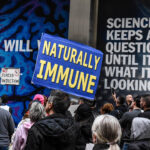Mother’s Little Helper
Late last summer, in a move that supporters described as a victory for female sexuality, the U.S. Food and Drug Administration approved a drug that manipulates serotonin, dopamine and norepinephrine levels in targeted areas of the brain. The purpose: To increase sexual desire in pre-menopausal women diagnosed with a clinically low libido.
Just six months later, that decision — along with the safety and efficacy of the drug, known as flibanserin and marketed as Addyi — has been brought into question by researchers who found that this much-heralded “female Viagra” might be less effective at addressing the problem of low female libido than originally thought. They also suggested that even its modest effects come with “clinically significant” increases in a variety of unsexy side effects, from dizziness and drowsiness to nausea and fatigue.
Representatives of Valeant, the company that swooped in with $1 billion to acquire the of Addyi after the FDA gave its approval last August, have been battling a deluge of negative press since Monday, when the new analysis was first published in the medical journal JAMA Internal Medicine. Throw in an unrelated federal securities investigation of Valeant, a tumbling stock price, and charges by some critics that the FDA caved to marketing pressure in issuing its approval of flibanserin, and the debate over the safety and efficacy of the drug is certain to continue.
But for all its rancor, the controversy masks a much more basic question: Does the disorder for which Addyi is prescribed really exist, or is it simply a malady that the pharmaceutical industry lobbied into existence, so it could create and sell a drug to treat it?
Sexual dysfunction of any kind, male or female, first appeared in a dedicated chapter in the Diagnostic and Statistical Manual of Mental Disorders, or DSM — psychiatry’s official diagnostic reference — in 1980. This section of the DSM was subsequently revised several times, and it was eventually expanded to include female sexual dysfunction, or FSD, an umbrella disorder that encompassed a wide spectrum of problems ranging from the fuzzy and generalized to the painful and concrete. These included hypoactive sexual desire disorder, or HSSD, which flibanserin is designed to treat, as well as sexual aversion disorder, sexual arousal disorder, orgasmic disorder, as well as dyspareunia (painful intercourse), and vaginismus (an involuntary contraction of the vagina, preventing sex).
The most recent edition of the DSM has now merged desire and arousal into a single entry known as female sexual interest/arousal disorder, or FSIAD. This update has drawn the ire of some critics, who have argued that desire and arousal are two very distinct aspects of female sexual response. At the same time, some sexologists were pleased that these updates also include more stringent requirements for diagnosis.
Either way, it has been well-documented that even the earliest entries into the DSM on sexual dysfunction often grew out of collaborations between independent researchers and their colleagues in the pharmaceutical industry. A 2003 analysis published in the British Medical Journal, for example, demonstrated that it was pharmaceutical company representatives, thriving on the success of Viagra and other drugs aimed at treating male erectile dysfunction, who pushed researchers for the development of new disease categories for women in the DSM.
By way of just one example, that BMJ analysis pointed to an earlier study — published in the Journal of the American Medical Association in 1999 and among the most frequently cited on the topic of female sexual dysfunction — which analyzed data from a 1992 National Health and Social Life Survey. The findings: Nearly half of all women surveyed — 43 percent, versus just 31 percent for men — reported experiencing sexual dysfunction of one sort or another, with 22 percent of that number citing low sexual desire in particular.
Two of the three authors of that study — which later drew questions on its methodology — had ties to the pharmaceutical company Pfizer, the maker of Viagra. And it would not be the last analysis of female sexuality that the pharmaceutical giant — or one of its competitors — had some connection to.
In 2005, the International Journal of Impotence Research published a piece on sexual problems among women and men, fueled by numbers acquired from the Pfizer-funded Global Study on Sexual Attitudes and Behaviors. Again, it was found that in some parts of the world, over 40 percent of women were experiencing sexual problems. And in 2008, Boehringer Ingelheim, the initial developers of flibanserin, sponsored a survey that also showed that one in 10 women had low libido.
This trend in what appears to be purpose-driven research has generated a good deal of heated discussion among sexuality researchers, many of whom decry the steady and, as they see it, mercenary medicalization of women’s sexuality. They also lament the absence of nuanced research into how male and female sexuality, including sexual response, might differ.
Such is the position of groups like the New View Campaign, which has been endorsed by the National Women’s Health Network, the Association for Women in Psychology, and Planned Parenthood of NYC, among other organizations and individual physicians. The group, which was founded in 2000 by American psychologist and sex researcher Leonore Tiefer, argues on its website that “the infusion of industry funding into sex research and the incessant media publicity about ‘breakthrough’ treatments have put physical problems in the spotlight and isolated them from broader contexts. Factors that are far more often sources of women’s sexual complaints — relational and cultural conflicts, for example, or sexual ignorance or fear — are downplayed and dismissed.”
In 2012, The Journal of Sex Research published an entire issue devoted to the medicalization of sex — including a historical account by Tiefer of the “medicalization and de-medicalization of sex therapies throughout history.” Among the many recent developments examined in the 100-page special issue is what the authors characterized as “pharmaceutical ‘disease mongering’ following the commercial success of Viagra.”

After being blocked from approval twice before, the FDA’s 2015 decision to approve flibanserin was remarkable in part for what many perceived to be the agency’s own lukewarm safety and efficacy assessments. Indeed, flibanserin’s approval came with a long list of conditions reflecting the FDA’s concerns about the side effects, which include low blood pressure and fainting in patients who drink alcohol while taking the drug.
Doctors are also required to complete a training course before being allowed to prescribe it.
“Assessing flibanserin has proven challenging,” wrote Hylton V. Joffe, an endocrinologist and head of the reproductive products division of the FDA’s Center for Drug Evaluation and Research, along with several agency co-authors, in an essay for the New England Journal of Medicine earlier this year. Joffe and his colleagues highlighted the drug’s arduous journey through multiple official reviews and public advisory meetings, and they conceded that opinions on whether or not to approve flibanserin, given its benefit-risk profile, were divided even among the FDA committee.
Critics say the divisions at FDA were much more telling than that. In an editorial published alongside the JAMA Internal Medicine study, Steven Woloshin and Lisa M. Schwartz, both professors of medicine and co-directors of the Center for Medicine in the Media at the Dartmouth Institute for Health Policy and Clinical Practice in New Hampshire, revealed that the FDA’s own clinical medical and pharmacology reviewers had voted against approving flibanserin. They were overruled by their division directors.
“While it is unclear how strongly politics influenced the decision,” Woloshin and Schwartz wrote, “it is clear that the science was weak.”
Tiefer of the New View Campaign was less circumspect, saying in an email message: “This highly unusual maneuver further illustrated the intrusion of politics into what should be a medical and scientific process.”
Whether or not that’s true, the results of three clinical trials, which found that the drug could increase a woman’s monthly tally of satisfying sexual encounters by an average of one (the JAMA analysis suggested the true average improvement was closer to just one-half of one sexual encounter, whatever that might mean) won the day. Personal testimonies from women, who told agency officials at a 2014 meeting that they felt the need for a drug like flibanserin, might have also played a role. “Although nonpharmacologic approaches to HSDD are important,” Joffe and his colleagues wrote, “we recognized that some women could benefit from drug therapy.”
That echoed the long-held position of advocacy groups like Even the Score — an organization supported by nonprofits like The Association of Reproductive Health Professionals and the National Organization for Women — which considered the approval of flibanserin to be a win for feminism. As flibanserin was going up for FDA approval for the third time, the organization sent out press releases pointing out that there were already 26 government-approved drugs made available to treat sexual dysfunction in men. They accused the FDA of being sexist because of the lack of any comparable drug for women.
As it stands, Even the Score is backed by Sprout Pharmaceuticals, which manufactured Addyi until the company was acquired by Valeant. Press reports have attributed the very founding of the organization to Sprout, although Valeant contends that Sprout was merely a sponsor of the campaign — alongside more than two-dozen other women’s health organizations and industry partners — providing funding to help support its development and management.
Either way, it seems clear that women’s health experts and advocates are split over flibanserin’s approval — which may not be all that surprising. Women’s sexual desire is a complex confluence of circumstances that includes hormones, brain chemistry, cultural expectations, and a barrage of interior questions that tend to distract from sex. Unlike Viagra, which acts on smooth muscle cells to allow the penis to become erect more readily when needed, drugs for HSDD are designed to target women’s brains. In the case of flibanserin, the drug increases the effects of desire-enhancing chemicals such as dopamine, while simultaneously decreasing the impact of inhibitors such as serotonin.
Lori Brotto, an Associate Professor in the Department of Obstetrics and Gynecology at the University of British Columbia, and a member of one of the committees that worked on updates to the most recent edition of the DSM, champions a more multifaceted approach to female sexual problems. A psychologist who regularly works with women who are concerned they may have female sexual dysfunction, Brotto uses a mix of cognitive behavioral therapy, mindfulness exercises, couple’s therapy, and a systems therapy approach. “It just depends on the particular client and her constellation of symptoms,” she says.
Brotto noted that one of the reasons there’s such a focus on medically-based treatments is because some experts believe that female libido issues can, at least sometimes, be neurochemical. But she also believes that in many instances, there are plenty of non-drug solutions, and that other motives are also at work. “The weight of literature is on drug trials, because that’s where all the money is,” she says. “There’s a bias in the kind of science that is getting done.”
Even if that’s true, the question remains: What precisely are doctors and psychiatrists and psychologists — even ones like Brotto — treating? Is reduced female libido really a disease, or just a natural response to life? Diagnosing a woman with low sexual desire, after all, suggests that there is some established threshold for how much desire she should be feeling in the first place.
Kristen Mark, a behavioral health scientist and director of the Sexual Health Promotion Lab at the University of Kentucky, is among many researchers working to develop better measurement tools for diagnostic and research purposes on these very questions. While she’s skeptical about the benefits of flibanserin, she acknowledges that there may someday be a medication that does help women who are unhappy with their level of desire.
“We are developing a scale that measures sexual desire as a state,” says Mark. “Something that may vary from day to day and partner to partner.”
She and her team of researchers hope to find a way to quantify both spontaneous and responsive desire — and the ways both can shift over time. It is research like this, she hopes, that may someday lead to better medications and to better treatments in general.
When asked via email Wednesday about the recent JAMA study and criticisms of flibanserin’s approval, FDA spokeswoman Andrea Fischer suggested that regulators were keeping an eye on new developments. “The agency continually monitors post-marketing safety of approved drug products, including Addyi,” Fischer said, “and remains committed to informing the public in a timely manner when the FDA identifies safety issues.”
In the meantime, Valeant is standing by its product.
“‘Normal sexual desire’ is unique to each woman,” said Tracy Valorie, who heads up marketing of Addyi for Valeant, in an emailed statement. “Addyi restores a woman to her previous level of ‘normal.’ Each woman can decide what is normal for her.” Valorie also pointed out that the drug was specifically approved to treat acquired hypoactive sexual desire disorder, meaning that a woman should have previously felt desire, “In the case of acquired HSDD,” Valorie said, “it represents a change, and each woman decides if this change is a problem for her, and if it is distressing.”
Valorie also pointed to results of a brain imaging study published in the Journal of Sexual Medicine, which shows that women with HSDD demonstrate different patterns of brain activation in response to sexual stimuli relative to women who do not report distressing low sexual desire. “This finding may suggest that women with HSDD process sexual stimuli differently than women without HSDD, which may affect their experience of sexual desire.”
Many experts remain skeptical.
“Marketing has driven pharmaceutical policy, no doubt,” says Ray Moynihan, the author of the 2010 book “Sex, Lies, and Pharmaceuticals: How Drug Companies Plan to Profit from Female Sexual Dysfunction,” and a senior research fellow at Bond University in Australia. “Companies have spent a lot of time trying to create need for their products, and one way to create need is to expand need, and to turn more people into patients,” Moynihan said. “There are few better examples of this than the corporate-sponsored creation of female sexual dysfunction.”
Addyi’s poor performance in its initial weeks on the market seemed to speak to that lack of need. In its first three weeks on the market, doctors wrote just 227 prescriptions for Addyi. By contrast, during the first month of its approval in 1998, more than half a million men got prescriptions for Viagra.
“The flibanserin saga is unsatisfying,” Woloshin and Schwartz wrote in their JAMA editorial. “The FDA approved a marginally effective drug for a non–life-threatening condition in the face of substantial — and unnecessary — uncertainty about its dangers. Women with distressing sexual desire problems need good treatments,” they added. “We all need a drug approval process that delivers good decisions based on adequate evidence.”
Steph Auteri is a freelance writer and editor whose work has appeared in the Virginia Quarterly Review, Ploughshares, Pacific Standard, Salon, and Jezebel, among other publications. She is the editor of the website Good in Bed, and she blogs about motherhood at Mom.me.










